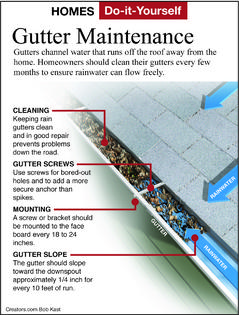Here's How: Keep Your Gutters From Clogging
Dear James: I have noticed rainwater running down over a window, and I am worried it might damage the siding. How often should I inspect and clean my gutters and downspouts? -- Tracie K.
Dear Tracie: A good rule of thumb is to check and clean them twice a year, preferably in the fall and spring. If you have time or have help to do it only once a year, do it in the fall. If you keep them maintained, it will be a pretty quick job each time.
Within one year, the seeds from trees can start to sprout in poorly maintained gutters. This tight accumulation of roots and debris will definitely inhibit the water flow. During heavy rains, water can flow over the edge of the gutters down the wall of the house. This can cause rotting or water seepage problems in a crawl space or basement.
A sunny, dry day is the best time to tackle gutter cleaning. The dry leaves and debris in the gutter can be removed with a leaf vacuum or leaf blower. Some models have attachments specifically for this purpose. You can also climb the old ladder and use the tried and true method of reaching in and scooping out the gunk. This also gives you the opportunity to inspect your gutters for any needed repair.
Move the ladder often. Never do your stretching exercises while cleaning the gutter. Reaching or bending your body too far could cause a serious accident. Stand on the ladder below the level of each gutter. And never stand on the roof to clear the gutters: It is too easy to slip and slide -- and certainly not a great place to practice your skiing.
Start by cleaning the gutters at a corner close to the downspout. Remove all debris blocking the downspout, and stuff a rag in the opening. Sweep the debris into a pile and remove it from the gutter with gloved hands or with a trowel. Hang a bucket on a ladder rung and toss the debris in it.
Move the tools as far in the opposite direction of the downspout as you can safely reach. Carefully climb down the ladder with the bucket of debris. Empty the bucket into the compost pile. Move the ladder about 6 feet from the downspout and repeat the process.
Once the gutters are cleared, do a test to make sure that water in the gutters and downspouts flows out smoothly. Flush the gutter with a full spray of water from a garden hose. This will show if there is standing water or blockages in the downspouts. Also look for any leaks, especially at the seams.
If you find standing water, the gutter probably needs to be repositioned. The gutter should slope downward at least 1/4 inch for every 10 feet of length. Some builders recommend 1/4 inch every 5 feet. First, try bending the gutter hangers a little. If more adjustment is needed, you may have to reposition them to eliminate the standing water.
If the water does drain out, but very slowly, down the downspout, it is probably partially clogged with leaves that must be cleared. Use a standard plumber's snake or drain auger to clear the clog. It is best to work your way up from the bottom to avoid compacting the leaves even more.
If you get frequent blockages in your downspouts, install leaf strainers in the downspout opening. In a heavily wooded lot, it is good idea to install wire mesh leaf guards over the entire length of the gutters.
========
Send your questions to Here's How, 6906 Royalgreen Dr., Cincinnati, Ohio, 45244 or visit www.dulley.com. To find out more about James Dulley and read features by other Creators Syndicate writers and cartoonists, visit the Creators Syndicate website at www.creators.com.
Copyright 2024 Creators Syndicate Inc.







